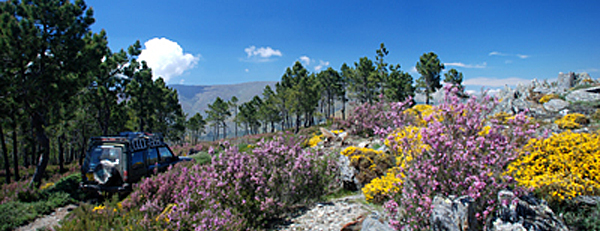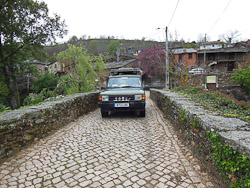|
 A mountain landscape adorned with wild flowers A mountain landscape adorned with wild flowers
|
A photo Safari in the Serra da Estrela, Portugal
Our well-practiced travel plan started at Raymond Bird’s house in May 2013
where we made a quick check of equipment, documents and supplies.
We then drove to Portsmouth, boarded the Brittany ferry to
Santander and settled into our coffin sized cabins.
 Raymond sampling local produce
Raymond sampling local produce |

Crossing into Portugal |  Traditional villages
Traditional villages |
We boarded the good ship ‘Pont Aven’, a well designed cruiser with open air access, good catering and nice bars. We rendezvoused at the main restaurant at 8.00pm and ordered an old favourite, the self-serve buffet.
We devoured our well stacked plates like teenagers and then darted back for a second helping when the waiter wasn’t watching. This would be the last such meal for a few weeks, I reminded Raymond. “Yes”, he said, knowing the limits of my campsite cuisine.
24 hours later we arrived at Santander. We drove to Bragança and entered Portugal. The border town at Rio del Onor was very traditional, half in Spain and half in Portugal. Villagers here work collectively and will join forces to harvest hay, herd livestock and undertake communal tasks.
We took a long drive down a succession of tracks, trails and finally accepted the offer of a local farmer who led us, on his tractor, to a junction where he explained with increasingly wild gesticulations, the best route to ‘the bridge’.
Passing drifts of wild flowers in lush meadows we came to a deepening gorge with the steep sides concealing the river far below us. At lunchtime we sighted a wonderful old bridge. I reminded Raymond that this had never been built for vehicles, and when we arrived we had to swing back both wing mirrors to squeeze through the entrance.
It was a substantial medieval construction of local stone with a high centre arch and two lesser arches buttressing either side. We paused in the sunshine for an undisturbed lunch of pilchards, Rye Vita and a glass of Portuguese wine.
We drove up steeply out of the river valley. It was a very loose shale road and we sent several stones ricocheting off on either side. We passed through Miranda do Douro and continued south. Here they speak their own language, Mirandês, unknown to either Spanish or Portuguese.
 Camping in a field of wild peonies
Camping in a field of wild peonies |
 |
 |
That night we camped ‘wild’, slightly to Raymond’s anxiety (“Have we got permission…?”) at a splendid site in a field of wild peonies just below a small natural lake. It was far from anywhere in an agricultural haven of small, flower decked grazing land. The track led down to the river Douro, lost in a deep canyon bounding the Spanish border on the steep walls to the east. An impenetrable natural boundary.
On the oak trees there were several large galls housing wasp larvae, a configuration I hadn’t seen before. Some had been invaded by ants and we spend a few minutes cracking open these hard oak leaf galls to see what was inside them.
In the evening a farmer appeared and welcomed us to Portugal. We chatted a little, through the medium of Raymond’s French linguistic skills, which neither the farmer nor I understood, and lots of arm-waving. With many smiles he left and wished us a happy stay.
I opened the ‘Kitmax TwinTop Tuckbox’ and brought forth, at sunset, a sumptuous meal of lamb stew accompanied by French beans with new potatoes, and a boiled onion apiece. All accompanied by our new found Portuguese wine and followed by crème caramel and a cup of tea. How wonderfully a meal improves when consumed out of doors…
|

River Douro | |
In the morning we drove down to the gorge where I saw an eagle swoop up to his eyrie on the cliff and deposit a fish into the talons of his mate. Overhead, vultures circled and buzzards scoured the meadows for voles.
|
 Cistus rockrose Cistus rockrose
|
|
We then drove to Freixo where we lodged in an ancient house, owned by the King’s fiscal servants in medieval times. We drove to the lake on the river Douro and set up our table at the water’s edge. There was no one in the entire area. The river was 200 metres wide here, and flat calm. Across the other side was Spain. I cooked another memorable dinner and we cherished the great stillness of the evening.
Next day we drove further south, still hugging the Spanish border, and arrived at Castelo Rodrigo. Here we met a guide who led us to a nature reserve where José had arranged for us to camp. It was a large tract of land bound by stone walls, abandoned farms and little flower filled paddocks. It borders a ravine bound by a high cliff where some eight pairs of Griffon vulture nest. Other raptors and a host of nesting birds are to be seen and heard. Small mammals are sustained in a rich environment of untenanted land undisturbed by humans.
|
 |

Entering the Nature Reservve
|
The guide took his leave and we spent a lovely, isolated night in a wild meadow enclosed by a stone wall and accompanied by crickets in the evening and birdsong in the morning. The wild flowers beckoned us and waved in the morning breeze. Sweet smelling broom (Cytisus scoparius) grew everywhere and the land was carpeted in yellow. Cuckoos and hoopoes vied for supremacy while hawks soared overhead in the clear blue sky. A lone fox passed by, undisturbed by our presence in his wild domain.
We gathered ourselves together and left for our main goal, the Serra da Estrela.
This long series of high granite ridges, now a national park, hosts jagged crests and crags interspersed with gorges, streams and lakes. Everywhere there is dense woodland clinging to steep ravines. Over every high ridge there is another magnificent view.
|

Perfumed carpets of broom | |
On José’s recommendation, we stayed at a waterside campsite at Valhelas and pulled out our big scale maps. They do not show latitude and longitude, so traditional map reading skills are demanded. Raymond pored over the maps and directed us up a precipitous track bound by invasive trees, fallen branches and multi coloured blooms. Once we had to retrace our steps as the track just closed in around us.
Gaining height, the bush and scrub gave way to forestry where our track was easier to navigate. We reached a junction which was not marked on the map, but by reading our altitude and following the contour lines on the map, Raymond was able to positively identify our track, route and heading. We continued ascending to 1,260m (4,133 ft) and passed a watch tower high on a ridge. We paused to admire the sweeping view of this wild countryside.
|

Ridge drive in the Estrela range | |
We lunched under some trees in a small hollow filled with flowers and surrounded by broom. We ate ham-dressed croissants, a tin of pilchards, green salad with cucumber, tomato and onion, lashings of mayonnaise and a glass of Portuguese wine. The afternoon continued with more tracks more views and ever more wildflowers, and we returned to camp around teatime. What a great, gratifying and rewarding day this has been.
 Yellow broom, cytisus scoparius
Yellow broom, cytisus scoparius |
 |
 |
At our customary sun-downer drink that evening, I congratulated the navigator on his navigating, and the navigator congratulated the driver on his driving. Then we poured ourselves another drink and both congratulated José on the route he had prepared for us. He had done a great job introducing us to a beautiful area in an unknown quarter of Portugal.
|

Steep ascents and steeper descents |
 |
Next day was more of the same. We were getting into our stride and went higher and further and followed long abandoned tracks in this magnificent Estrela range. We drove up a sculptured ridge on the very crest and reached a peak where we had an unbroken view of half the horizon. I stopped to take photographs at every new vista and we cooed over the flowers and shrubs growing so profusely over this region.
The Land Rover performed with distinction and confidence, and I did some terrific climbs and descents, negotiating some seriously eroded tracks on the way.
Further south we came to Pomarinho, a small campsite in a beautiful wild garden surrounded by flowers, shrubs and sunshine. We settled in and set up our two tents. Next day we started early to drive an amazing trail up into the high hills marking the Spanish border.
We hit the ridge that divides Spain and Portugal and drove along the border with a wheel in each country. We encountered some very difficult ascents on loose shale peppered with football sized rocks. Some of these slopes were at least 30%, some steeper still. Raymond’s navigating skill are superb, he can find these lost, abandoned routes.
By 4pm cloud was building up, and at over 600m (2,000ft) we did not want to become cloud bound. We started a long, picturesque if circuitous route back down the ridge and regained the security of our campsite two hours later.
|
 |
 Dinner by the lake side
Dinner by the lake side |
That day snow fell in Serra da Estrela and our trip would have been impossible. We survived a wet night, the only bad weather of our trip, and moved off next day.
We crossed and re-crossed the Spanish/Portuguese border for the next few days, making our way slowly home. This has been a great trip and will be long remembered for the welcome of the local people, the route that José set out for us and for the wild and beautiful country we were able to explore.
 The Land Rover was unstoppable
The Land Rover was unstoppable |
 |
 Last view of the Douro
Last view of the Douro |
Our route through Portugal hugged the Spanish border

|
Blog posted prior to departure
"The tents are packed, the desert dinners in stock and the route plotted on ‘Google Earth’. Navigator Raymond Bird and photographer Kit Constable Maxwell depart for Portugal on May 7th
We take the Brittany ferry to Santander, then drive to Bragança, Portugal.
From this point we follow tracks and trails, camping en-route, crossing upland country, nature reserves and national parks.
We will live off local produce supplemented by soya stew and vac-packed ingredients from the Kitmax TwinTop Tuckbox.
We carry recovery skids, a hi-lift winch, extra fuel and water, two tents and sleeping bags. Maximum altitude will be around 6,000ft. There will be rivers to cross and steep sided gorges to negotiate".
The trip will be the subject of an illustrated talk later in the year. Check this website www.kitmax.com for updates.